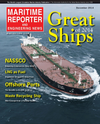
Page 22: of Maritime Reporter Magazine (December 2014)
Great Ships of 2014
Read this page in Pdf, Flash or Html5 edition of December 2014 Maritime Reporter Magazine
22 Maritime Reporter & Engineering News • DECEMBER 2014
LEGAL BEAT gressional action in the U.S.
The U.S. cannot make strides in LNG regulation without Congress playing a signifi cant role. The House Transporta- tion and Infrastructure Committee and the Senate Commerce, Science and
Transportation Committee should take the lead on developing legislation to fi ll the regulatory and policy gaps discussed above. Such legislation should include a one-stop permitting model for infra- structure development similar to the one used in the Ocean Thermal Energy Con- version Act of 1980 (Pub. L. 96-320).
It also should confi rm that LNG can be used as a fuel that complies with current and future EPA and ECA standards.
To avoid the political pitfalls of ballast water legislation, which has been mired down in endless Congressional debate over preemption, the legislation should set national guidelines that state and lo- cal governments can use as guidance but does not create a patchwork quilt of state and local laws and regulations with vary- ing standards.
The U.S. needs to designate a lead agency to develop the policy and the regulatory structure for the use of LNG as a transportation fuel. One option is MARAD with the assistance of the
Coast Guard, EPA and the Army Corps of Engineers. The DNV-GL study, above, describes the patchwork of agen- cies in charge of various aspects of this problem—too many to lead to an effi - cient result.
Once designated, the lead agency should convene a workshop with indus- try, NGOs and key regulatory agencies to debate the policy and regulatory gaps, and identify the need for fi nancial incen- tives to promote LNG as a clean trans- portation fuel.
The lead agency, with other interested agencies, must promptly address at least three key issues: crew and operator safe- ty, fi nancial assistance programs and the
Marine Highway Program.
To address issues of crew and opera- tor safety, the U.S. Department of La- bor, working closely with the U.S. Coast
Guard and respective maritime unions and schools, should administer programs to increase safety.
Agencies must also consider fi nancial assistance programs to incentivize the construction of new ships, ship engine conversions and new portside bunker- ing infrastructure. The following federal grant and assistance programs could be utilized: the Environmental Protection
Agency’s Diesel Emissions Reduction
Act (DERA) Program; the Department of Transportation’s (DOT) Transporta- tion Investment Generating Economic
Recovery (TIGER) infrastructure grant program; port security grants at the Fed- eral Emergency Management Agency (FEMA), a part of the Department of
Homeland Security (DHS); Small Ship- yard Grants at MARAD/DOT; the Capi- tal Construction Fund (CCF), which is implemented by MARAD and the In- ternal Revenue Service; and MARAD’s title XI loan guarantee program, which assisted in the fi nancing of the TOTE containerships, above.
The Marine Highway Program (MHP) is also essential for strengthening the
U.S. port bunkering infrastructure. This program, initiated by MARAD, has not had much Congressional support, but will be useful for designating ports that can handle infrastructure for bunker- ing operations. To make MHP a reality,
MARAD and other agencies should ex- plore the use of private investment and public-private partnerships for develop- ing and funding infrastructure projects, similar to those authorized by the Water
Resources and Reform Development Act of 2014. (Pub. L. 113-121).
Unless there is legislative action to create a legal framework for LNG to thrive, and executive action to designate a lead agency to consolidate layers of regulation, the growth of LNG as a ma- rine fuel may not reach its potential.
Conclusions
The U.S. has taken the fi rst steps to promote LNG as a clean maritime trans- portation fuel, but Congress and the Ad- ministration must now develop a well- coordinated LNG policy and regulatory regime and a package of needed fi nan- cial incentives and training programs to foster an environment in which LNG can continue to safely take off as a marine fuel. * Joan Bondareff would like to thank
Stefanos Roulakis, an associate in the
Firm’s maritime, international trade, and government contracts group, for his assistance in writing this article.
The Author
Joan M. Bondareff, of counsel at Blank
Rome LLP, represents clients in many industries and state and local govern- ments in marine transportation, environ- mental and legislative issues.
T: 202.772.5911 e: [email protected]
MARAD touts that the TOTE ships “will be the most environmentally friendly containerships in the world.”
Designed by DSEC, a subsidiary of South Korea-based Daewoo Shipbuilding, the ships include DSEC’s patented LNG fuel-gas supply system and a MAN ME-GI dual-fuel slow-speed engine. Notably, NASSCO also has a contract with American Petroleum
Tankers to build four new product carriers that will be ready for conversion to use LNG fuel.
MR #12 (18-25).indd 22 12/2/2014 12:15:59 PM

 21
21

 23
23
